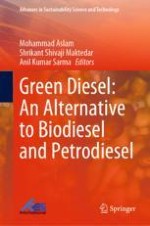This book covers the entire spectrum of green diesel and their applications in existing CI engines. This book discusses how a green diesel is a better fuel than biodiesel and petrodiesel and more suitable fuels for sustainable future development. The book begins with a concise overview of the fundamentals of the green diesel properties, preparation, and characterization of green diesel using hydroprocessing technology. The book covers recent developments in the domain of green diesel derived particularly from the second-/third-generation feedstocks. Various topics covered in this book include the catalysts involved in the processing of green diesel, characterization of the products as per ASTM/EN protocols. In addition, the book also illustrates characteristic features of green diesel and how it is different from biodiesel and petrodiesel. Other chapters cover performance and emission characteristics of green diesel in CI engines and techno-economic analysis. Moreover, the current status of green diesel industries is also incorporated. This book is of particular interest to graduate students and academic or industrial researchers/professionals working in the area of green diesel/green energy, bioenergy and mechanical, automobile, and chemical engineering. This book makes a forceful foundation for the establishment of green diesel refineries/biorefineries for a sustainable, cleaner, and greener future.
